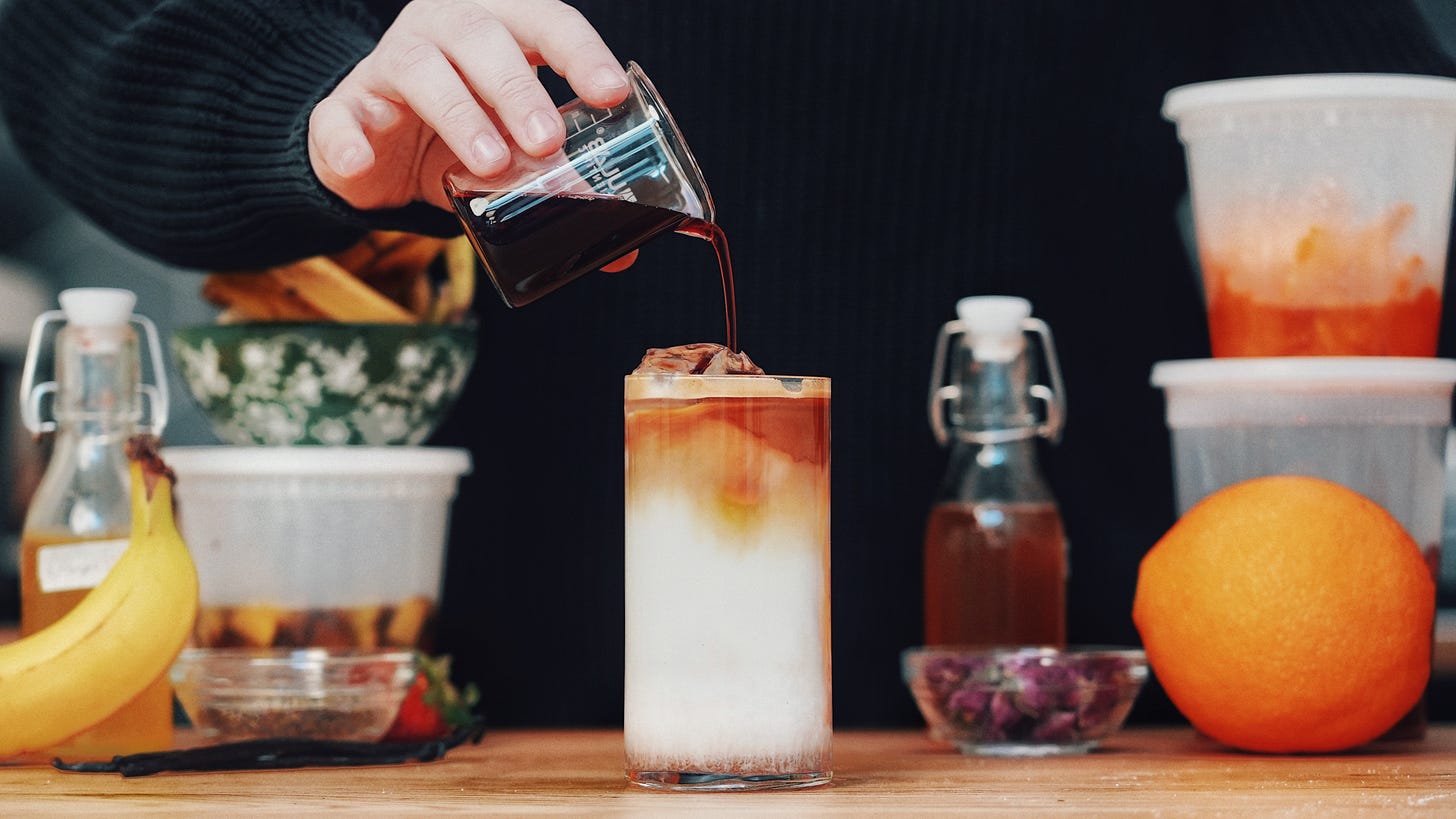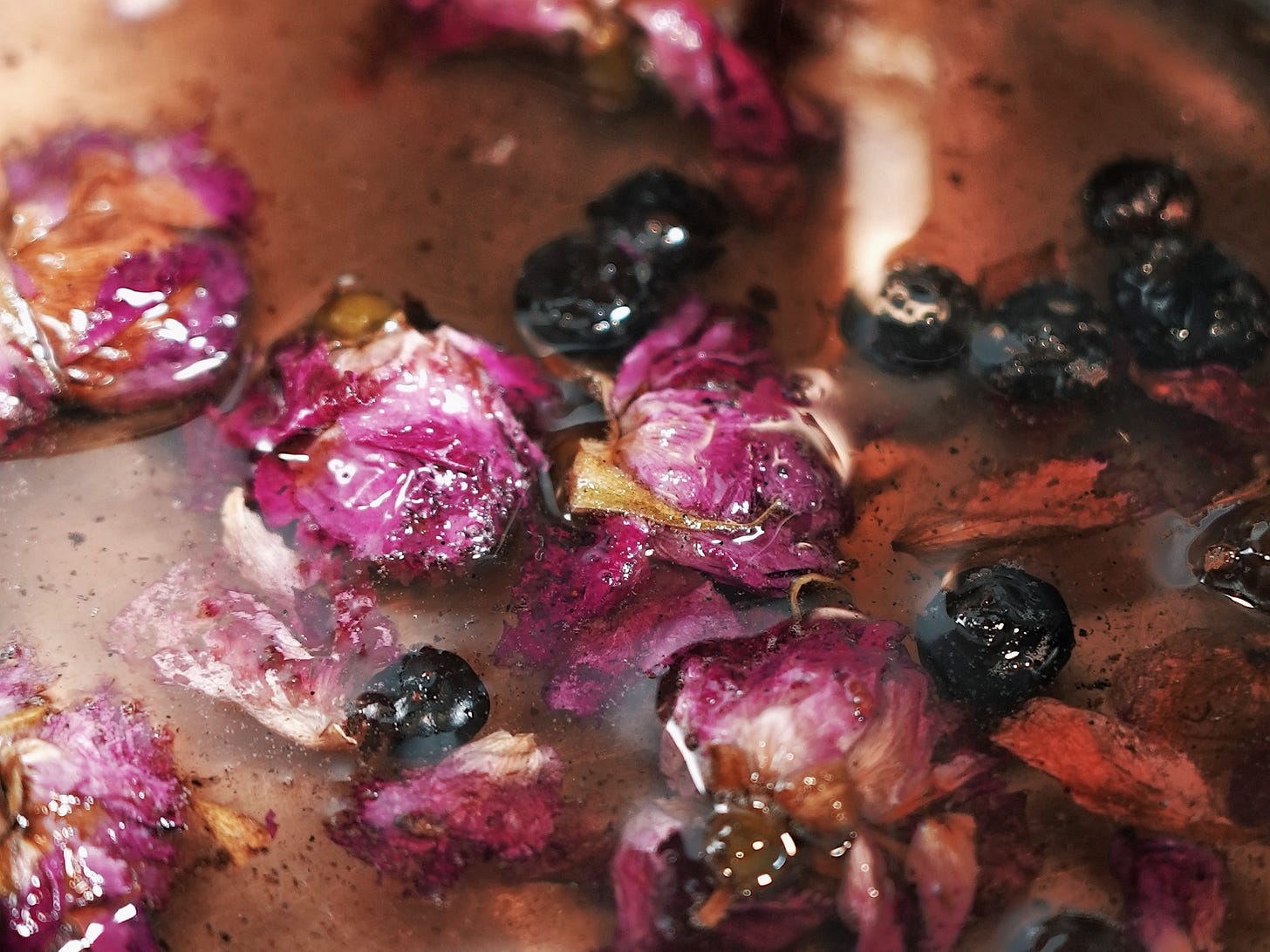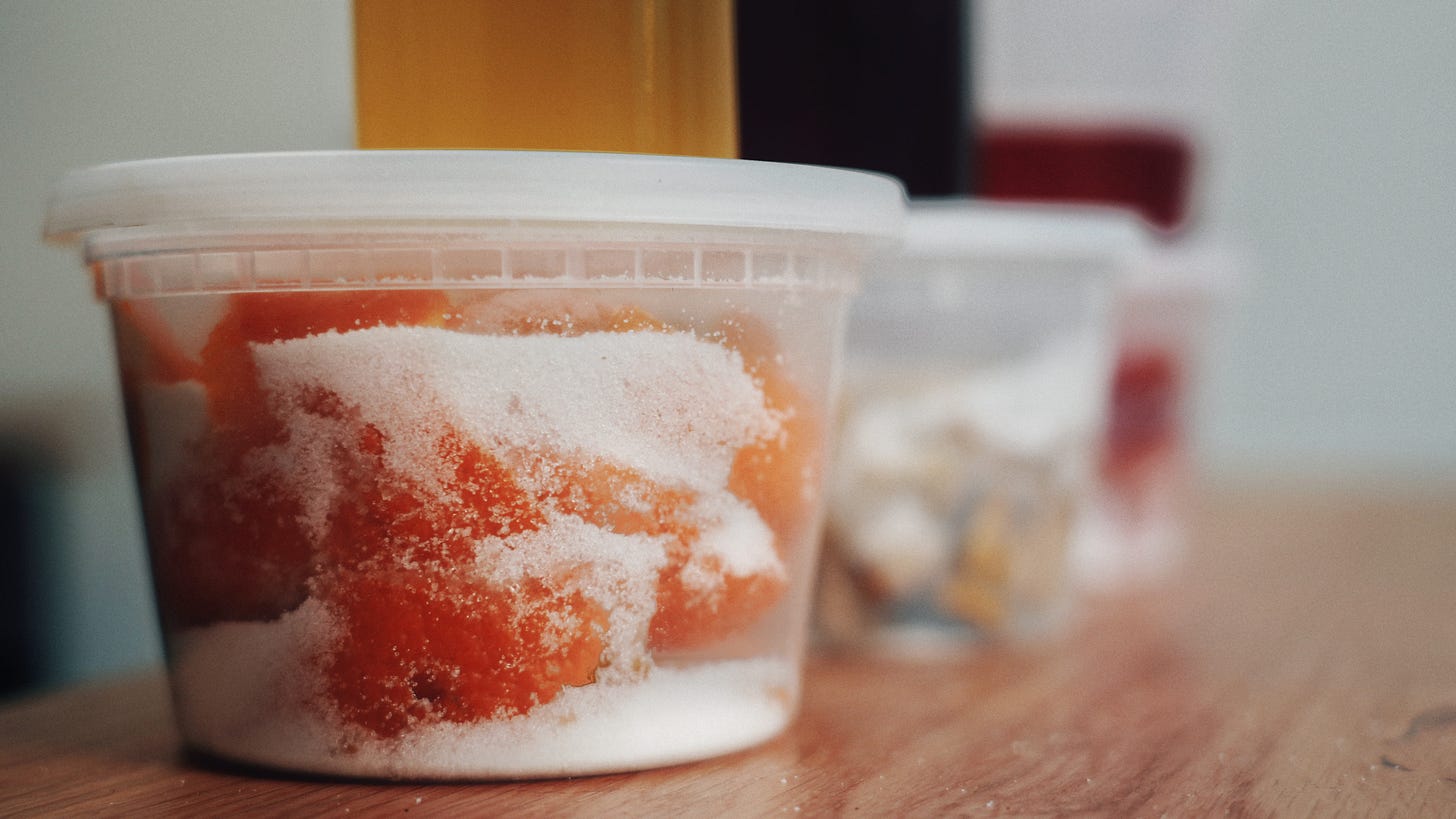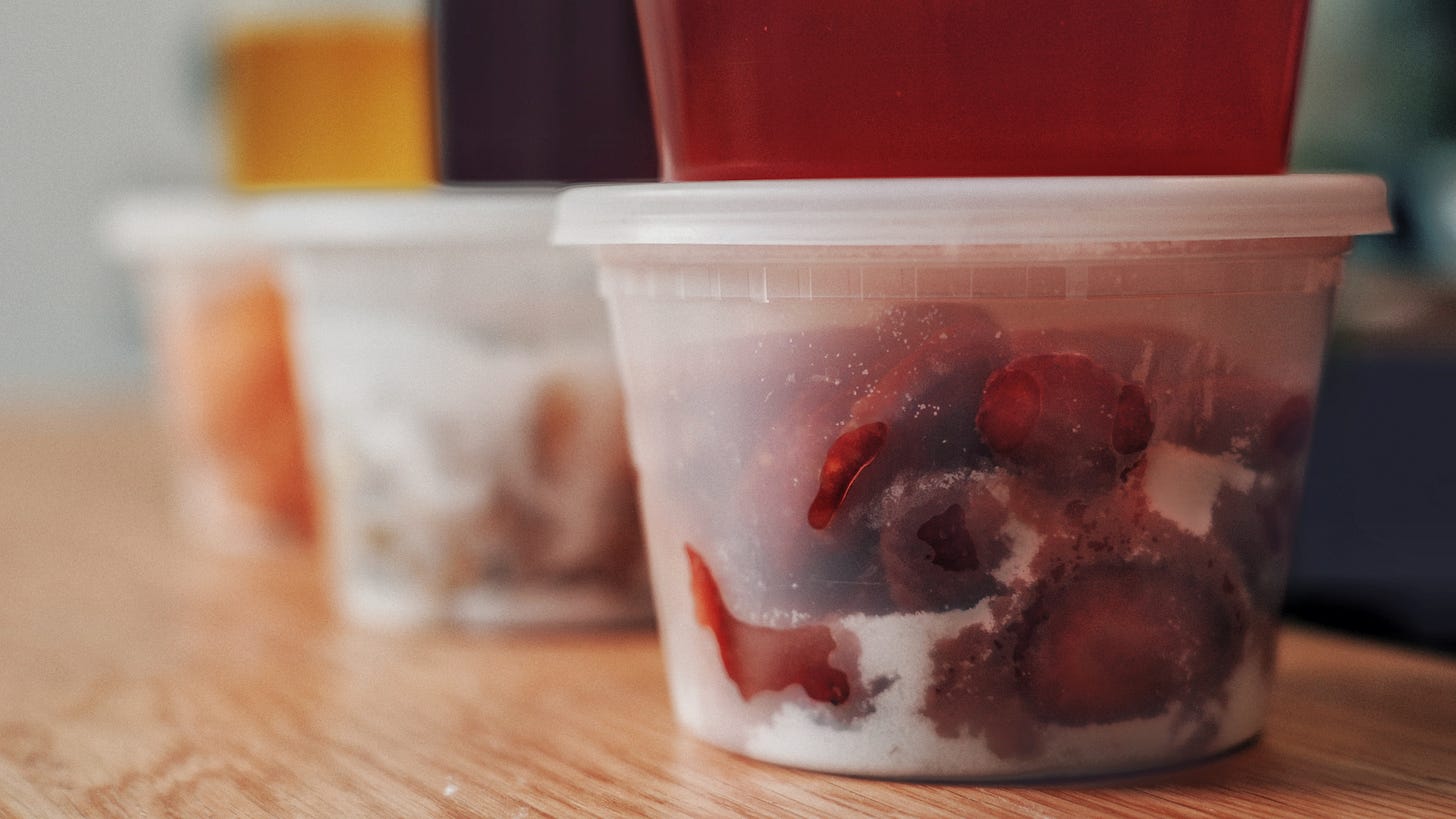How to make *the most* scrumptious syrups for your coffee
The sticky, highly versatile ingredient you can easily make at home.
I will gleefully fight anyone who tells me I shouldn’t put syrup in my coffee. And by fight, I mean that I will respectfully disagree and tell them that syrup can be can be an incredible vehicle for flavor.
I have three primary methods that I use when creating syrups for lattes and signature drinks, depending on what flavor I’m intending to impart. Syrup formats are best conveyed in ratios, allowing you to adjust the ingredients to make the amount that you need. Below, you’ll find my general guidelines but as always, I encourage you to use them as starting points rather than rules.
For a full video tutorial of these syrups, click here.
General Tools
Fine sieve for straining out solids
Kitchen scale
Clean bottles or containers to store syrup
Syrup #1 - Infused rich syrup
This is the simplest and most common syrup you’ll see due to its versatility and long shelf life. I make these types of syrups when my infusing ingredients are dry—think spices, tea, or dried flowers.
Ratio
2 parts sugar by weight
1 part water by weight
2.5% of the sugar’s weight for the infusing ingredient (example: 200g sugar → 5g of dry infusing ingredient)
Process
Combine sugar, water, and infusing ingredient in a sauce pan on medium-low heat. Stir occasionally as the sugar begins to dissolve, ensuring that the liquid does not surpass a low simmer. Once the sugar has fully dissolved, remove the saucepan from heat and allow it to cool, continuing to let the flavor infuse.
Once it has cooled, strain out the infusing ingredient and transfer the finished syrup into a clean bottle. Store in the fridge for up to two weeks.
Infusing ingredient suggestions: Cloves, cardamom, dried lavender, dried rose, juniper berries, earl grey tea, cinnamon, black pepper.
Drink suggestion: Summer’s Light, a lavender peppercorn latte.
Syrup #2 - Oleo saccharum
I love citrus and coffee together. And it makes sense! Coffee is acidic—lighter roasted coffees often boasting citric flavor notes such as orange, lemon curd, and limeade.
The words oleo saccharum quite literally mean oil and sugar respectively. This two-ingredient syrup has been around for hundreds of years and is often used in alcoholic milk punches. However, for our purposes, this syrup is one of the best ways to impart citric flavors in lattes while avoiding the dreaded curdling that occurs when you directly combine citrus juice with milk.
Ratio
1 part citrus peel by weight
1 part sugar by weight
Process
Peel your citrus of choice, avoiding as much of the pith (bitter white part beneath the peel) as possible. In a small container, combine the peel and equal parts sugar. Muddle the ingredients together to begin extracting the peel’s oil before sealing the container. Leave the container to rest for 8-12 hours—this can be done at room temperature.
Once your oleo saccharum has formed, strain out the syrup from the peels and store in a clean container in the fridge for up to two weeks.
Optional: If I notice that there’s still undissolved on the peels after 8-12 hours, I like to ‘rinse’ my oleo saccharum with 10-15g of warm water before straining. This will loosen the syrup slightly and help ensure you’re not leaving flavor behind.
Citrus suggestion: Orange, grapefruit, lemon, lime, bergamot, yuzu.
Drink suggestion: The Side Hug, a warming drink featuring orange creamsicle foam and a double espresso.
Syrup #3 - Fruit syrup
This method of syrup-making is similar to an oleo saccharum but instead we’re relying on a fruit’s natural moisture rather than oil. This type of syrup is often known as cheong in Korean cuisine—however, our syrup isn’t going to have an extended fermentation.
Simply enough, we’re going to combine fresh fruit with sugar for an absolute flavor bomb of a final syrup.
Ratio
1 part chopped fruit or berries by weight
1 part sugar by weight
Process
Roughly chop your fruit or berries of choice, increasing the surface area that can be coated with sugar. In a container, combine your chopped fruit and sugar, giving it a mix so that the fruit pieces are thoroughly coated.
Seal and place the container in the fridge for 8-12 hours, removing when a thick syrup has formed. Strain out the fruit solids and store your fruit syrup in a clean bottle. Keep in the fridge for up to two weeks.
Note: Save the spent sugared fruit as a topping for ice cream/oat meal/pancakes/waffles.
Fruit & berries suggestion: Strawberries, banana peel, raspberries, rhubarb, cherries, blueberries.
Drink suggestion: The Screendoor 2.0, a tiki-inspired coffee drink with a banana coconut cold foam.
General tips
Make your syrup in a batch that you can use within two weeks. Some syrups, particularly those with a high sugar percentage, will last longer but I prefer to make sure that I’m regularly cycling batches.
You can mix and match ingredients in all of these formats.
I typically use turbinado sugar when using spiced/darker flavors and granulated cane sugar when working with more delicate flavors.
Go forth and make all the syrups! It’s so worth it.
Talk soon,
Morgan







as someone who's currently trying to develop syrups for a future cafe (hopefully), this tutorial is a godsend. Thank you, Morgan!
Here for use of Cheong in coffee by a Barista